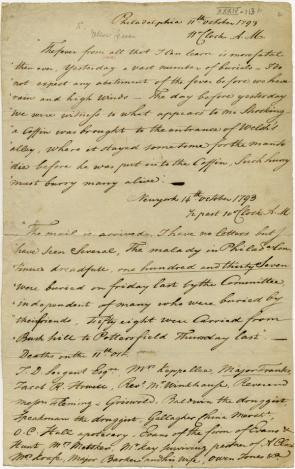Reports on the yellow fever epidemic, 1793
A Spotlight on a Primary Source by Unknown Correspondent
Between August 1 and November 9, 1793, approximately 11,000 people contracted yellow fever in the US capital of Philadelphia. Of that number, 5,000 people, 10 percent of the city’s population, died. The disease gets its name from the jaundiced eyes and skin of the victims. Other symptoms include fever, headache, and "black vomit" caused by bleeding into the stomach. At the time, it was thought that yellow fever was caused by rotting vegetable matter, and it was believed to be contagious; the disease is actually spread by mosquitos.
The epidemic created panic in the capital, causing 17,000 people, including President Washington and other members of the federal government, to flee to the countryside. This document, from the papers of Secretary of War Henry Knox, contains two reports written during the peak of the epidemic in the first few weeks of October. Knox had moved his office to Montgomery County before taking his family back to Boston. The document is possibly a compilation of accounts Knox’s staff were receiving from elsewhere. One report notes: "The day before yesterday we were witness to what appears to me Shocking – a Coffin was brought to the entrance of Welsh’s alley, where it stayed sometime for the man to die before he was put into the Coffin, Such hurry must burry many alive."
The war department was keeping Knox informed about the situation since Washington and the Cabinet were trying to determine if it was safe for the government to return to Philadelphia in November.
Excerpt
The fever from all that I can learn is more fatal than ever, yesterday a vast number of burials – I do not expect any abatement of the fever before we have rain and high winds – The day before yesterday we were witness to what appears to me Shocking – a Coffin was brought to the entrance of Welsh’s alley, where it stayed sometime for the man to die before he was put into the Coffin, Such hurry must burry many alive.

